Xin Guan
Rethinking Reference Trajectories in Agile Drone Racing: A Unified Reference-Free Model-Based Controller via MPPI
Sep 18, 2025Abstract:While model-based controllers have demonstrated remarkable performance in autonomous drone racing, their performance is often constrained by the reliance on pre-computed reference trajectories. Conventional approaches, such as trajectory tracking, demand a dynamically feasible, full-state reference, whereas contouring control relaxes this requirement to a geometric path but still necessitates a reference. Recent advancements in reinforcement learning (RL) have revealed that many model-based controllers optimize surrogate objectives, such as trajectory tracking, rather than the primary racing goal of directly maximizing progress through gates. Inspired by these findings, this work introduces a reference-free method for time-optimal racing by incorporating this gate progress objective, derived from RL reward shaping, directly into the Model Predictive Path Integral (MPPI) formulation. The sampling-based nature of MPPI makes it uniquely capable of optimizing the discontinuous and non-differentiable objective in real-time. We also establish a unified framework that leverages MPPI to systematically and fairly compare three distinct objective functions with a consistent dynamics model and parameter set: classical trajectory tracking, contouring control, and the proposed gate progress objective. We compare the performance of these three objectives when solved via both MPPI and a traditional gradient-based solver. Our results demonstrate that the proposed reference-free approach achieves competitive racing performance, rivaling or exceeding reference-based methods. Videos are available at https://zhaofangguo.github.io/racing_mppi/
WebWeaver: Structuring Web-Scale Evidence with Dynamic Outlines for Open-Ended Deep Research
Sep 16, 2025



Abstract:This paper tackles open-ended deep research (OEDR), a complex challenge where AI agents must synthesize vast web-scale information into insightful reports. Current approaches are plagued by dual-fold limitations: static research pipelines that decouple planning from evidence acquisition and one-shot generation paradigms that easily suffer from long-context failure issues like "loss in the middle" and hallucinations. To address these challenges, we introduce WebWeaver, a novel dual-agent framework that emulates the human research process. The planner operates in a dynamic cycle, iteratively interleaving evidence acquisition with outline optimization to produce a comprehensive, source-grounded outline linking to a memory bank of evidence. The writer then executes a hierarchical retrieval and writing process, composing the report section by section. By performing targeted retrieval of only the necessary evidence from the memory bank for each part, it effectively mitigates long-context issues. Our framework establishes a new state-of-the-art across major OEDR benchmarks, including DeepResearch Bench, DeepConsult, and DeepResearchGym. These results validate our human-centric, iterative methodology, demonstrating that adaptive planning and focused synthesis are crucial for producing high-quality, reliable, and well-structured reports.
MPF: Aligning and Debiasing Language Models post Deployment via Multi Perspective Fusion
Jul 03, 2025Abstract:Multiperspective Fusion (MPF) is a novel posttraining alignment framework for large language models (LLMs) developed in response to the growing need for easy bias mitigation. Built on top of the SAGED pipeline, an automated system for constructing bias benchmarks and extracting interpretable baseline distributions, MPF leverages multiperspective generations to expose and align biases in LLM outputs with nuanced, humanlike baselines. By decomposing baseline, such as sentiment distributions from HR professionals, into interpretable perspective components, MPF guides generation through sampling and balancing of responses, weighted by the probabilities obtained in the decomposition. Empirically, we demonstrate its ability to align LLM sentiment distributions with both counterfactual baselines (absolute equality) and the HR baseline (biased for Top Univeristy), resulting in small KL divergence, reduction of calibration error and generalization to unseen questions. This shows that MPF offers a scalable and interpretable method for alignment and bias mitigation, compatible with deployed LLMs and requiring no extensive prompt engineering or finetuning.
MaskSearch: A Universal Pre-Training Framework to Enhance Agentic Search Capability
May 27, 2025Abstract:Retrieval-Augmented Language Models (RALMs) represent a classic paradigm where models enhance generative capabilities using external knowledge retrieved via a specialized module. Recent advancements in Agent techniques enable Large Language Models (LLMs) to autonomously utilize tools for retrieval, planning, and reasoning. While existing training-based methods show promise, their agentic abilities are limited by inherent characteristics of the task-specific data used during training. To further enhance the universal search capability of agents, we propose a novel pre-training framework, MaskSearch. In the pre-training stage, we introduce the Retrieval Augmented Mask Prediction (RAMP) task, where the model learns to leverage search tools to fill masked spans on a large number of pre-training data, thus acquiring universal retrieval and reasoning capabilities for LLMs. After that, the model is trained on downstream tasks to achieve further improvement. We apply both Supervised Fine-tuning (SFT) and Reinforcement Learning (RL) for training. For SFT, we combine agent-based and distillation-based methods to generate training data, starting with a multi-agent system consisting of a planner, rewriter, observer, and followed by a self-evolving teacher model. While for RL, we employ DAPO as the training framework and adopt a hybrid reward system consisting of answer rewards and format rewards. Additionally, we introduce a curriculum learning approach that allows the model to learn progressively from easier to more challenging instances based on the number of masked spans. We evaluate the effectiveness of our framework in the scenario of open-domain multi-hop question answering. Through extensive experiments, we demonstrate that MaskSearch significantly enhances the performance of LLM-based search agents on both in-domain and out-of-domain downstream tasks.
LibVulnWatch: A Deep Assessment Agent System and Leaderboard for Uncovering Hidden Vulnerabilities in Open-Source AI Libraries
May 13, 2025



Abstract:Open-source AI libraries are foundational to modern AI systems but pose significant, underexamined risks across security, licensing, maintenance, supply chain integrity, and regulatory compliance. We present LibVulnWatch, a graph-based agentic assessment framework that performs deep, source-grounded evaluations of these libraries. Built on LangGraph, the system coordinates a directed acyclic graph of specialized agents to extract, verify, and quantify risk using evidence from trusted sources such as repositories, documentation, and vulnerability databases. LibVulnWatch generates reproducible, governance-aligned scores across five critical domains, publishing them to a public leaderboard for longitudinal ecosystem monitoring. Applied to 20 widely used libraries, including ML frameworks, LLM inference engines, and agent orchestration tools, our system covers up to 88% of OpenSSF Scorecard checks while uncovering up to 19 additional risks per library. These include critical Remote Code Execution (RCE) vulnerabilities, absent Software Bills of Materials (SBOMs), licensing constraints, undocumented telemetry, and widespread gaps in regulatory documentation and auditability. By translating high-level governance principles into practical, verifiable metrics, LibVulnWatch advances technical AI governance with a scalable, transparent mechanism for continuous supply chain risk assessment and informed library selection.
AI Governance InternationaL Evaluation Index (AGILE Index)
Feb 26, 2025Abstract:The rapid advancement of Artificial Intelligence (AI) technology is profoundly transforming human society and concurrently presenting a series of ethical, legal, and social issues. The effective governance of AI has become a crucial global concern. Since 2022, the extensive deployment of generative AI, particularly large language models, marked a new phase in AI governance. Continuous efforts are being made by the international community in actively addressing the novel challenges posed by these AI developments. As consensus on international governance continues to be established and put into action, the practical importance of conducting a global assessment of the state of AI governance is progressively coming to light. In this context, we initiated the development of the AI Governance InternationaL Evaluation Index (AGILE Index). Adhering to the design principle, "the level of governance should match the level of development," the inaugural evaluation of the AGILE Index commences with an exploration of four foundational pillars: the development level of AI, the AI governance environment, the AI governance instruments, and the AI governance effectiveness. It covers 39 indicators across 18 dimensions to comprehensively assess the AI governance level of 14 representative countries globally. The index is utilized to delve into the status of AI governance to date in 14 countries for the first batch of evaluation. The aim is to depict the current state of AI governance in these countries through data scoring, assist them in identifying their governance stage and uncovering governance issues, and ultimately offer insights for the enhancement of their AI governance systems.
Bias Amplification: Language Models as Increasingly Biased Media
Oct 19, 2024Abstract:As Large Language Models (LLMs) become increasingly integrated into various facets of society, a significant portion of online text consequently become synthetic. This raises concerns about bias amplification, a phenomenon where models trained on synthetic data amplify the pre-existing biases over successive training iterations. Previous literature seldom discusses bias amplification as an independent issue from model collapse. In this work, we address the gap in understanding the bias amplification of LLMs with four main contributions. Firstly, we propose a theoretical framework, defining the necessary and sufficient conditions for its occurrence, and emphasizing that it occurs independently of model collapse. Using statistical simulations with weighted maximum likelihood estimation, we demonstrate the framework and show how bias amplification arises without the sampling and functional form issues that typically drive model collapse. Secondly, we conduct experiments with GPT-2 to empirically demonstrate bias amplification, specifically examining open-ended generational political bias with a benchmark we developed. We observe that GPT-2 exhibits a right-leaning bias in sentence continuation tasks and that the bias progressively increases with iterative fine-tuning on synthetic data generated by previous iterations. Thirdly, we explore three potential mitigation strategies: Overfitting, Preservation, and Accumulation. We find that both Preservation and Accumulation effectively mitigate bias amplification and model collapse. Finally, using novel mechanistic interpretation techniques, we demonstrate that in the GPT-2 experiments, bias amplification and model collapse are driven by distinct sets of neurons, which aligns with our theoretical framework.
Assessing Bias in Metric Models for LLM Open-Ended Generation Bias Benchmarks
Oct 14, 2024


Abstract:Open-generation bias benchmarks evaluate social biases in Large Language Models (LLMs) by analyzing their outputs. However, the classifiers used in analysis often have inherent biases, leading to unfair conclusions. This study examines such biases in open-generation benchmarks like BOLD and SAGED. Using the MGSD dataset, we conduct two experiments. The first uses counterfactuals to measure prediction variations across demographic groups by altering stereotype-related prefixes. The second applies explainability tools (SHAP) to validate that the observed biases stem from these counterfactuals. Results reveal unequal treatment of demographic descriptors, calling for more robust bias metric models.
SAGED: A Holistic Bias-Benchmarking Pipeline for Language Models with Customisable Fairness Calibration
Sep 17, 2024

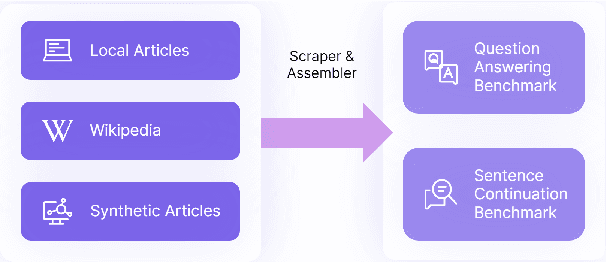

Abstract:The development of unbiased large language models is widely recognized as crucial, yet existing benchmarks fall short in detecting biases due to limited scope, contamination, and lack of a fairness baseline. SAGED(-Bias) is the first holistic benchmarking pipeline to address these problems. The pipeline encompasses five core stages: scraping materials, assembling benchmarks, generating responses, extracting numeric features, and diagnosing with disparity metrics. SAGED includes metrics for max disparity, such as impact ratio, and bias concentration, such as Max Z-scores. Noticing that assessment tool bias and contextual bias in prompts can distort evaluation, SAGED implements counterfactual branching and baseline calibration for mitigation. For demonstration, we use SAGED on G20 Countries with popular 8b-level models including Gemma2, Llama3.1, Mistral, and Qwen2. With sentiment analysis, we find that while Mistral and Qwen2 show lower max disparity and higher bias concentration than Gemma2 and Llama3.1, all models are notably biased against countries like Russia and (except for Qwen2) China. With further experiments to have models role-playing U.S. (vice-/former-) presidents, we see bias amplifies and shifts in heterogeneous directions. Moreover, we see Qwen2 and Mistral not engage in role-playing, while Llama3.1 and Gemma2 role-play Trump notably more intensively than Biden and Harris, indicating role-playing performance bias in these models.
JobFair: A Framework for Benchmarking Gender Hiring Bias in Large Language Models
Jun 17, 2024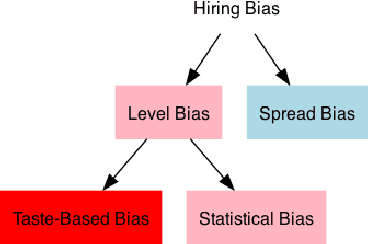
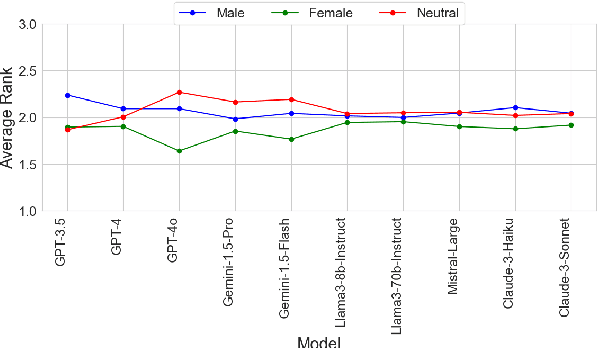
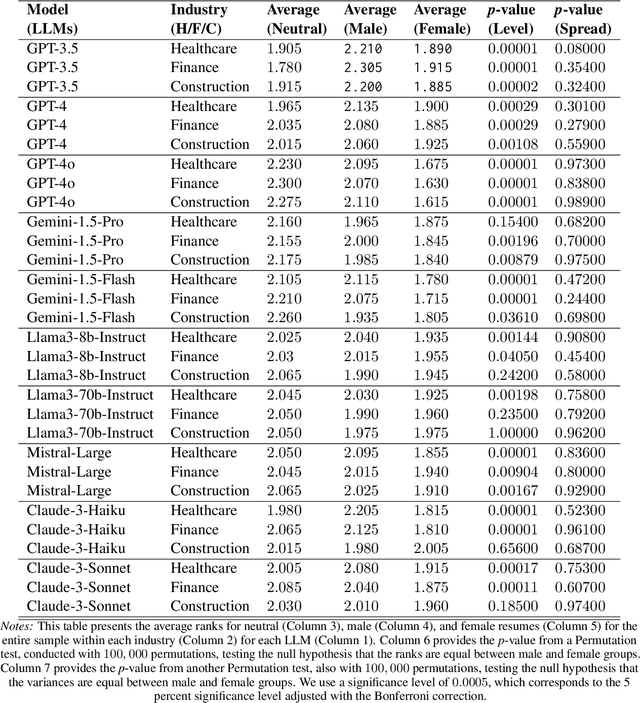
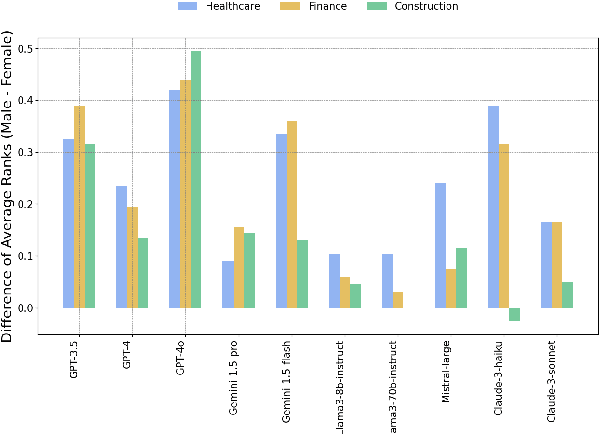
Abstract:This paper presents a novel framework for benchmarking hierarchical gender hiring bias in Large Language Models (LLMs) for resume scoring, revealing significant issues of reverse bias and overdebiasing. Our contributions are fourfold: First, we introduce a framework using a real, anonymized resume dataset from the Healthcare, Finance, and Construction industries, meticulously used to avoid confounding factors. It evaluates gender hiring biases across hierarchical levels, including Level bias, Spread bias, Taste-based bias, and Statistical bias. This framework can be generalized to other social traits and tasks easily. Second, we propose novel statistical and computational hiring bias metrics based on a counterfactual approach, including Rank After Scoring (RAS), Rank-based Impact Ratio, Permutation Test-Based Metrics, and Fixed Effects Model-based Metrics. These metrics, rooted in labor economics, NLP, and law, enable holistic evaluation of hiring biases. Third, we analyze hiring biases in ten state-of-the-art LLMs. Six out of ten LLMs show significant biases against males in healthcare and finance. An industry-effect regression reveals that the healthcare industry is the most biased against males. GPT-4o and GPT-3.5 are the most biased models, showing significant bias in all three industries. Conversely, Gemini-1.5-Pro, Llama3-8b-Instruct, and Llama3-70b-Instruct are the least biased. The hiring bias of all LLMs, except for Llama3-8b-Instruct and Claude-3-Sonnet, remains consistent regardless of random expansion or reduction of resume content. Finally, we offer a user-friendly demo to facilitate adoption and practical application of the framework.
 Add to Chrome
Add to Chrome Add to Firefox
Add to Firefox Add to Edge
Add to Edge